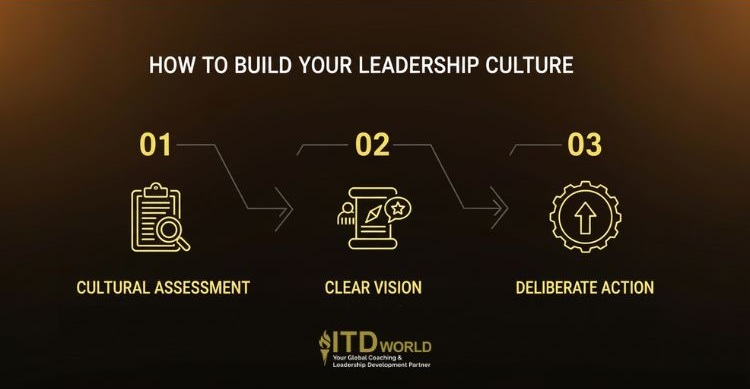Learn what makes a positive leadership culture, plus how to assess the current one and lead a successful cultural transformation.
Every organization has a culture, and yet few people actually understand where it comes from. The truth is that it isn’t shaped by mission statements on a wall, but by the daily actions and priorities of the management team. This “leadership culture” – the shared habits and values of the leadership group – is the source code for the whole corporate atmosphere, setting the standards for what is rewarded, tolerated, and cherished across the company.
|
Author: Jonathan M. Pham |
Highlights
- Leadership culture is the unwritten, observable set of shared mindsets, behaviors, and values consistently demonstrated by an organization’s management team. It plays a crucial role in driving engagement, fueling innovation, and ultimately improving overall business performance.
- A healthy leadership culture is characterized by high trust, psychological safety, aligned purposes, a strong sense of accountability, and a significant investment in growth opportunities for all team members.
- Building and changing a leadership culture involves a three-step process: conducting a cultural assessment using both quantitative and qualitative methods, translating aspirational values into observable behaviors, and closing the gap through leadership development and systemic reinforcement.
What is Leadership Culture?
Leadership culture is the shared mindset, behaviors, and values consistently demonstrated by an organization’s management team. It is the unwritten, observable “how we lead around here” – the set of norms that dictates how leaders interact with their teams, make decisions, drive performance, and handle challenges.
A leadership culture is not what is written in a company manual or displayed on a poster; rather, it is a living, breathing entity that dictates the reality of the workplace every day. Regardless of what the official mission statement says, it is the management’s actions that truly drives the collective mindset and behaviors. To put it simply, the entire organization’s culture will inevitably grow in the “shadow” cast by its senior executives.
This cause-and-effect relationship is most clearly seen when there is a gap between a company’s values and its leaders’ actions. For instance, let’s say a management team publicly champion the importance of “work-life balance” and “employee well-being” in their town hall meetings – and yet these same individuals consistently send emails at 10 PM, publicly praise those who work through the weekend, and rarely take their own vacation time. In this case, the leadership culture – one that models and rewards constant availability – completely undermines the stated value. The effect is an atmosphere of burnout and cynicism, where employees quickly learn that the unwritten rule (“you must always be working to get ahead”) is far more important than the written one.
The Business Case for a Positive Leadership Culture
- Drives engagement & retention
According to Gallup’s research, the manager alone accounts for up to 70% of the variance in team engagement. A positive leadership culture, by definition, creates better managers, which in turn translates to highly motivated teams where people are inclined to give their best effort. The result, obviously, is an improvement in productivity – coupled with lower rates of turnover.
- Fuels innovation & agility
Studies have noted a correlation between high psychological safety – a direct output of a healthy culture – and better learning. When people trust their managers and others enough to speak up their own ideas, it’s much easier for the team to be exposed to diverse perspectives and eventually come up with breakthrough solutions.
- Improves overall business performance
Ultimately, engaged teams in a stable, high-trust environment simply perform better. Research by McKinsey & Company on “organizational health” (a measure heavily influenced by leadership culture) consistently shows that companies in the top quartile of health deliver a total shareholder return that is three times higher than those in the bottom quartile.

Relationship between culture and leadership
A notable real-world example is the case of the UK’s National Health Service (NHS). Extensive research, often cited by healthcare policy institutes like The King’s Fund, has established a direct link between the compassionate and inclusive leadership culture within the NHS and tangible outcomes, including:
- Better outcomes: Higher levels of patient satisfaction and lower mortality rates.
- Higher well-being: Significantly lower rates of employee stress and burnout.
- Improved financial performance: Lower absenteeism and reduced spending on costly temporary agency staff.
- etc.
Key Pillars of a High-Performing Leadership Culture
- High trust & psychological safety
In this culture, team meetings are characterized by healthy, constructive debate, not silent agreement. Leaders are often the first to admit when they don’t have the answer or when they have made a mistake – in other words, they embrace authenticity and model vulnerability. “Failures” are consistently and publicly framed as learning opportunities for the entire team.
- Alignment & purpose
The entire management team is unified in its strategic direction and consistently connects the day-to-day work of their teams to the organization’s larger mission. As a result, energy and resources are focused on the right priorities, preventing the strategic drift and siloed efforts that plague many organizations.
- A sense of accountability & ownership
When a project misses a deadline, the leader’s first response is not to ask, “Who is to blame?” but rather, “What did we learn from this, and what is our plan to get back on track?” By taking ownership of the collective outcome, they set an example of personal responsibility that cascades down to the teams.
- Investment in growth opportunities
Leaders see themselves as “talent multipliers”, whose role is not just to manage people – but to actively enable them to advance higher. As such, developmental conversations are a regular and expected part of the management’s routine. Leaders are measured and rewarded not just for the collective output, but for their team’s growth – for example, by the number of their direct reports who are promoted to more senior roles.

This commitment to development extends beyond the current workforce; it involves recognizing the importance of a strong educational foundation that fosters future leaders. For many, the journey begins with rigorous qualifications. For instance, programs like the International A Level courses are designed to cultivate the critical thinking, analytical skills, and discipline that form the bedrock of effective leadership.
A culture that truly values growth, therefore, also implicitly values the academic and personal development that precedes one’s professional career.
How to Build & Evolve Your Leadership Culture
-
Conduct a cultural assessment
Any change journey must begin with an honest and data-driven understanding of your starting point. This requires moving beyond assumptions and anecdotes to see the leadership culture as it is truly experienced throughout the organization.
To get a complete picture, it is recommended to leverage a combination of quantitative and qualitative methods:
- Quantitative: Employ tools like anonymous surveys and analyze the aggregate data from 360-degree assessments across your entire leadership cohort. This will help identify broad, system-wide patterns and themes.
- Qualitative: Conduct confidential, professionally facilitated “listening sessions” with different employee groups. These conversations provide the rich context, stories, and specific examples that bring the quantitative data to life and reveal the “why” behind the numbers.
-
Define a clear vision
Next, the senior management team should come up with a compelling and unified vision for the future (aka your “North Star” culture). The most critical part here is to move beyond simply choosing aspirational words and to identify the observable behaviors that represent those values in action.
For example, let’s say “Ownership” is chosen as a core tenet of the desired leadership culture. In that case, the specific behaviors might be:
- “We take responsibility for setbacks without blaming other teams”
- “We proactively solve problems without waiting to be told”
- “We follow through on all of our commitments”
- etc.
Read more: Leadership Philosophy – How to Define Your True North & Follow It
-
Close the gap with deliberate action
This is the long-term, sustained effort of embedding the defined behaviors into the daily life of the organization. It is where the vision becomes a reality. This involves pulling three key levers:
- Leadership development: Provide targeted training, workshops, and coaching for all leaders, focused specifically on the skills and mindsets needed to visualize the new leadership culture.
- Systemic reinforcement: Align the core HR systems – i.e. hiring, promotion, and recognition – to reward and promote those who consistently exemplify the desired behaviors.
- Leading by example: The senior executive team must be the most visible champions of the change. Their daily actions and decisions are the most powerful communication tool they have.
Read more: Leadership Journey – How to Grow at Every Stage

Leadership Culture Change in Action: Lululemon Case Study
When Christine Day took over as CEO in 2008, Lululemon was a beloved brand with a powerful, cult-like following built on its values of wellness and personal development. However, the company’s rapid growth from a niche retailer to a major player was creating significant operational strain. Specifically, it was facing inefficiencies, underperforming stores, and strategic fragmentation that threatened its future scalability.
Day and her new leadership team quickly diagnosed that the very passion and autonomy that had fueled the brand’s early success were now, at a larger scale, creating fragmented teamwork and internal silos. Different parts of the business – from product design and marketing to retail operations – were operating with a high degree of independence. The leadership culture had not evolved as fast as the business was growing, and this lack of cross-functional collaboration was hindering execution.
Following the above-mentioned discovery, the leadership team’s mission became clear: they needed to realign the leadership culture to foster greater collaboration and operational discipline, but without losing the unique, values-driven, and empowering spirit that made the company special. The goal was to establish an architecture that could support a billion-dollar global brand, not just a successful local one.
To achieve this, Day’s team implemented several initiatives as follows:
- Breaking down silos: They restructured teams and devised new processes and meeting cadences that required cross-functional collaboration between departments to get things done.
- Introducing disciplined accountability: They implemented more rigorous operational planning, clearer financial targets, and stronger accountability for store and regional performance. This balanced the creative, “feel-good” aspects of the culture with a sharp focus on execution and results.
- Leaders as role models: The senior executive team had to visibly model this new, more integrated way of working. They shifted from protecting their individual functions to taking collective ownership for the company’s overall performance, demonstrating a united front to the rest of the organization.

Leadership culture in the workplace
Leadership Culture Quotes
Good leaders build products. Great leaders build cultures.
Adam Grant
Culture eats strategy for breakfast.
Peter Drucker
Determine what behaviors and beliefs you value as a company, and have everyone live true to them.
Denise Lee Yohn
Corporate culture is the only sustainable competitive advantage that is completely within the control of the entrepreneur.
David Cummings
Leadership Culture Books
- Huawei: Leadership, Culture, and Connectivity by Tian Tao, David De Cremer, Wu Chunbo
Chronicles Huawei’s rise from a small startup to a global telecom giant, focusing on Ren Zhengfei’s leadership style, customer-centric philosophy, and the fusion of Eastern and Western management values.
- The Culture Code by Daniel Coyle
Reveals the secrets of highly successful groups by exploring how leaders promote safety, share vulnerability, and establish purpose at work.
- Leaders Eat Last by Simon Sinek
Explores how great leaders establish environments of trust and cooperation, with case studies to demonstrate how empathy and safety drive performance.
- Delivering Happiness by Tony Hsieh
Shares the story of Zappos and how its unique culture – centered on customer service and employee happiness – became its competitive advantage.
- Work Rules! by Laszlo Bock
Features insights from Google’s former HR chief on building a high-performance culture through data-driven people practices and radical transparency.
- Culture Is the Way by Matt Mayberry
A playbook for leaders to intentionally shape culture as a strategic asset, with actionable steps to align values and behaviors.
- All In by Adrian Gostick & Chester Elton
Explains how leaders may establish cultures of belief and engagement, backed by research on high-performing teams across industries.
- Courageous Cultures by Karin Hurt & David Dye
Encourages leaders to foster environments where people may speak up, share ideas, and challenge the status quo without fear.
- Remote Not Distant by Gustavo Razzetti
Offers strategies for designing inclusive and collaborative cultures in hybrid and remote work environments.
- Building Corporate Soul by Ralf Specht
Introduces the “Soul System” to enable the creation of human-centric cultures that drive innovation and connection.

Build a High-Performing Leadership Culture with ITD World
At ITD World, we specialize in helping organizations cultivate the leadership capabilities and cultural frameworks needed to thrive through our wide array of integrated solutions, including:
- Culture assessment & diagnostic services: We provide expert facilitation and diagnostic tools to present a holistic picture of your current leadership culture, providing the essential starting point for any change initiative.
- Senior Leadership Development Program (SLDP): Designed to align your top team and refine the skills in strategic thinking and change management needed to lead the transformation.
- Coaching certifications: Equip your internal leaders with the competencies needed to empower their teams and foster an atmostphere of learning.
- Customized in-house programs: Long-term, bespoke solutions that integrate assessment, training, and coaching for sustainable growth.
Ready to take the next step? Contact ITD World today to learn how our expert partnership can help!
Other resources you might be interested in:
- Servant Leadership: A Transformative Management Philosophy
- Leadership Excellence: Moving From Manager to Multiplier
- Leadership Potential: How to Spot & Cultivate Future Leaders
- Diversity in the Workplace: Leveraging Differences to Fuel Success

